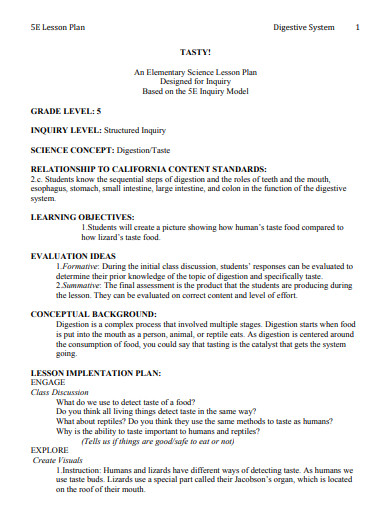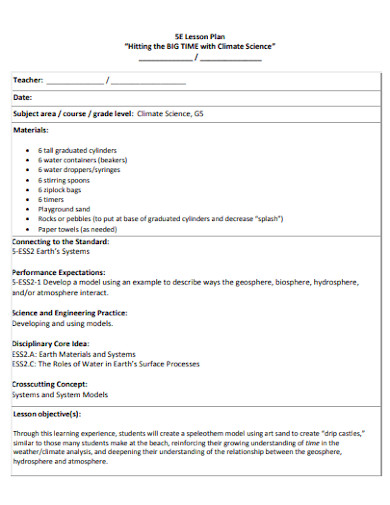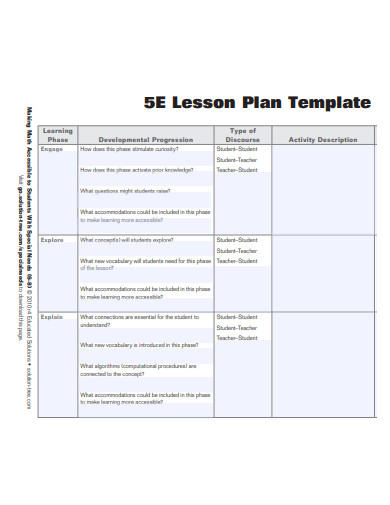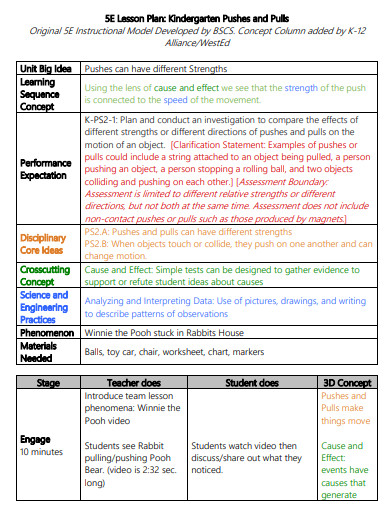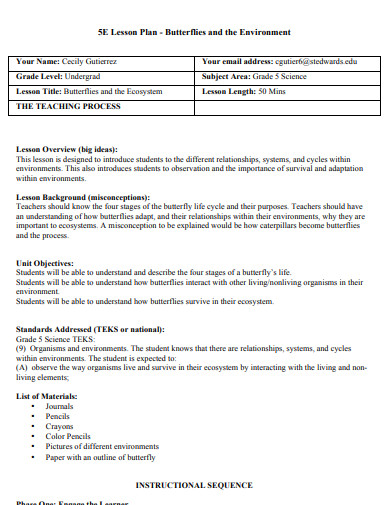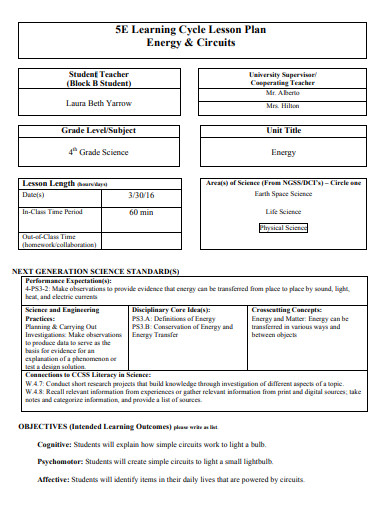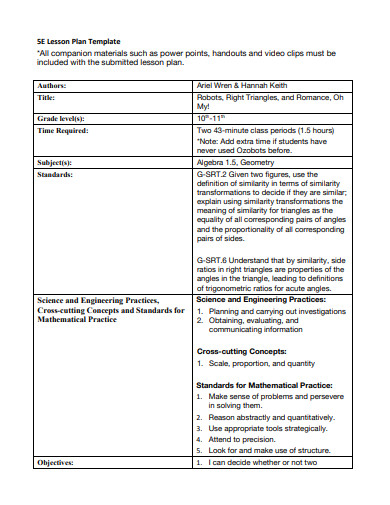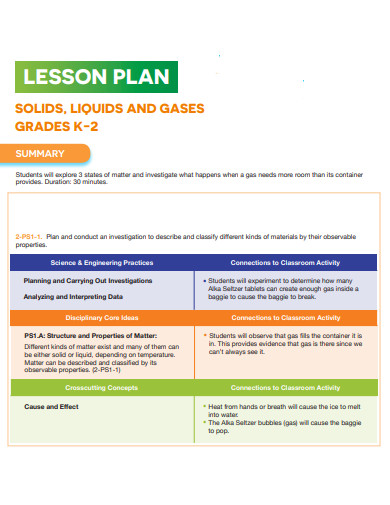The constructivist approach to learning, which proposes that individuals get their knowledge and sense of meaning from their experiences, serves as the foundation for the 5E lesson plan. Students can integrate newly acquired information with the perspectives they’ve developed in the past when they comprehend what they do and think about what they do. “Educational approaches such as inquiry-based learning, active learning, experiential learning, discovery learning, and knowledge building are all versions of constructivism,” says Beverlee Jobrack, an expert on the subject area.
FREE 10+ 5E Lesson Plan Samples
1. 5E Lesson Plan for English
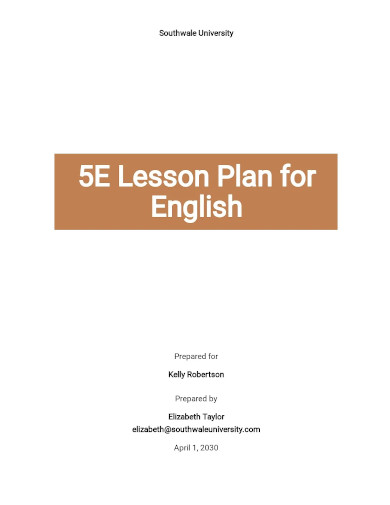
2. 5E Model Lesson Plan
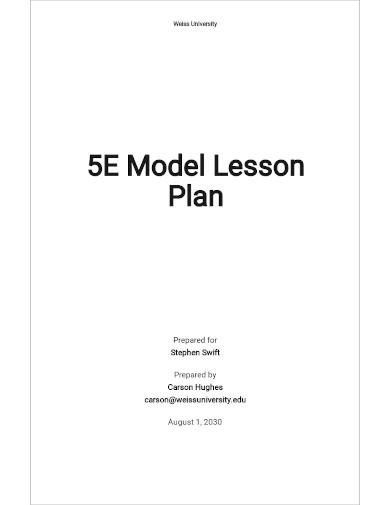
3. 5E Lesson Plan
4. 5E Student Lesson Plan
5. Sample 5E Student Lesson Plan
6. Sample 5E Lesson Plan
7. Environmental 5E Lesson Plan
8. 5E Learning Cycle Lesson Plan
9. Simple 5E Lesson Plan
10. 5E Lesson Plan Example
11. 5E Lesson Plan for Grade K-2
What Is a 5E Lesson Plan?
The 5E lesson supports the inquiry-based learning approach. Children are given the opportunity to make discoveries and, interestingly acquire new abilities thanks to it. By utilizing the 5E approach, educators can more efficiently and thoroughly organize the key objectives they will be pursuing.
How To Make a 5E Lesson Plan?
Engage, Explore, Explain, Elaborate, and Evaluate are the phases that are included in the 5Es educational approach. Educators have traditionally taught pupils to progress through these procedures in phases. You can read the stages listed below to create a well-constructed plan.
Step 1- Set Objectives
Write your lesson plan aim at the very top of the plan at the beginning of every lesson. The objective should only be one phrase long, have a powerful verb, and communicate to students what they will have learned or be able to achieve by the time the class is over. If you wish to add something extra, you may explain how they might do this (through video, games, flashcards, etc.).
Step 2- State The Standards
You are aware of the material that the pupils will study, but can you explain why they will study it? In all likelihood, you are a teacher in a state or district with educational standards, essentially lists of information every student must know to graduate from high school.
Step 3- Provide an Overview
Make use of broad strokes when outlining the significant concepts that will be covered in the lesson and what you will focus on. There is no need to worry about being extremely explicit. This is simply some basic information that will hopefully give you and others a better idea of what the upcoming class will include.
Step 4- Map Out Your Activities
Although there are certain schools that will not need you to plan out every minute of a class, you will probably find that being particular is helpful when you are first getting started. If there is a lot to cover in a predetermined amount of time, you should divide your plan into pieces that you can either speed up or slow down to accommodate changes as they occur.
What exactly are the five different components of a lesson plan?
The lesson topic, the class objectives, the method, effective time management, and student practice should all be included in a quality lesson plan.
What are the three types of lesson plan?
Detailed lesson plan, semi-detailed lesson plan, and understanding by design (UbD).
Which of these two types of lesson plans are there?
There are two distinct approaches to the process of lesson planning. The first one is an outline for a class doing observations. The second component is the preparation work for the instructor.
In every single course, there are going to be aspects of the material that you simply cannot anticipate. However, if you are well prepared, it will be much simpler to adjust to unforeseen circumstances and respond appropriately to your students. This will allow you to teach more effectively.
Related Posts
FREE 9+ 30-Day Marketing Plan Samples in PDF | MS Word | Apple Pages | Google Docs
FREE 3+ Sales Team Action Plan Samples in PDF | MS Word | Apple Pages | Google Docs
Marketing Plan For Small Business Samples
FREE 7+ Fashion Business Plan Samples in PDF
FREE 10+ Sprint Planning Samples In MS Word | Google Docs | PDF
FREE 10+ Wedding Planning Samples in MS Word | Apple Pages | Powerpoint | PDF
FREE 9+ Monthly Study Planner Samples in PSD | Illustrator | InDesign | PDF
FREE 9+ Sample Curriculum Planning Templates in PDF | MS Word
FREE 10+ Teacher Development Plan Samples in MS Word | Google Docs | Apple Pages | PDF
FREE 10+ Basketball Practice Plan Samples in PDF
FREE 12+ School Business Plan Samples in PDF | MS Word | Apple Pages | Google Docs
FREE 7+ Client Strategic Plan Samples in PDF | MS Word
FREE 11+ Trucking Business Plan Templates in PDF | MS Word | Google Docs | Pages
FREE 7+ Small Hotel Business Plan Samples PDF | MS Word | Apple Pages | Google Docs
FREE 14+ Bakery Business Plans in MS Word | PDF | Google Docs | Pages

